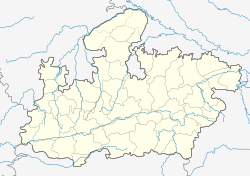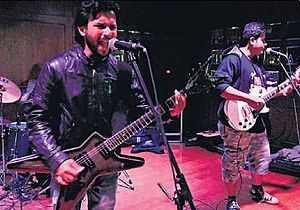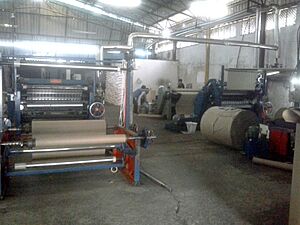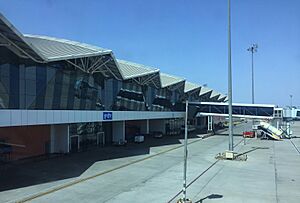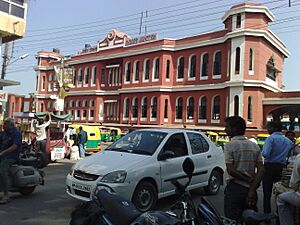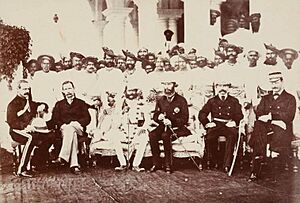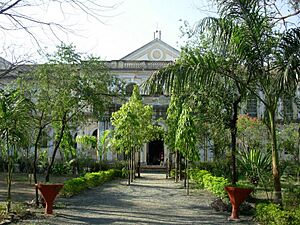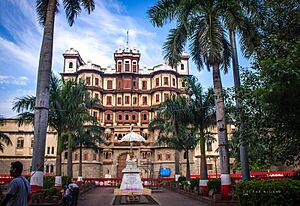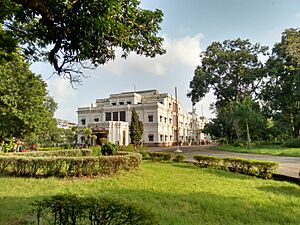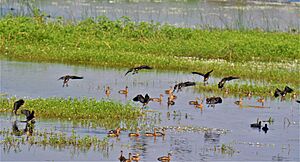Indore facts for kids
Quick facts for kids
Indore
Iṁdaura
|
|
|---|---|
|
From top, left to right: Rajwada Palace, Daly College, Yeshwant Club, Holkar Stadium, Indore Airport, Indian Institute of Management Indore, IIT Indore, IT Crystal Park, Atal Bihari Regional Park, Patalpani waterfall, Khajrana Ganesh Temple
|
|
| Nickname(s):
Street Food Capital of India
|
|
| Country | |
| State | |
| Region | Malwa |
| District | Indore |
| Ward | 85 wards |
| Government | |
| • Type | Municipal Corporation |
| • Body | Indore Municipal Corporation |
| Area | |
| • Metropolis | 530 km2 (200 sq mi) |
| • Metro | 1,200 km2 (500 sq mi) |
| Area rank | 6 |
| Elevation | 550 m (1,800 ft) |
| Population
(2011)
|
|
| • Metropolis | 1,994,397 |
| • Rank | 14th |
| • Density | 3,760/km2 (9,750/sq mi) |
| • Metro | 2,170,295 |
| • Metro rank | 15th |
| Demonym(s) | Indori |
| Time zone | UTC+5:30 |
| PIN |
4520XX
|
| Telephone code | 0731 |
| Vehicle registration | MP-09 |
| Official language | Hindi |
| Effective literacy rate (2011) | 85.5% |
| HDI (2016) | 0.755 (High) |
| Sex ratio | Female 925 Male 1000 |
| Climate | Cwa / Aw (Köppen) |
| Precipitation | 945 mm (37.2 in) |
| Avg. annual temperature | 24.0 °C (75.2 °F) |
| Avg. summer temperature | 41 °C (106 °F) |
| Avg. winter temperature | 17 °C (63 °F) |
| GDP Nominal (Indore District) | ₹64,813 crore (US$11 billion) (2020-21) |
| Website | , |
Indore (![]() i/ɪnˈdɔːr/) is the largest and most populated city in the Indian state of Madhya Pradesh. It is a major business center for the state. Indore is famous for being ranked as the cleanest city in India many times in a row. It is also a big education hub, home to important schools like the Indian Institute of Technology (IIT) and the Indian Institute of Management (IIM).
i/ɪnˈdɔːr/) is the largest and most populated city in the Indian state of Madhya Pradesh. It is a major business center for the state. Indore is famous for being ranked as the cleanest city in India many times in a row. It is also a big education hub, home to important schools like the Indian Institute of Technology (IIT) and the Indian Institute of Management (IIM).
Indore is located on the southern edge of the Malwa Plateau. It is about 553 meters (1,814 feet) above sea level. This makes it one of the highest major cities in Central India. The city is about 190 kilometers (118 miles) west of Bhopal, the state capital. In 2011, Indore had a population of nearly 2 million people. It is one of the most densely populated major cities in Central India.
Indore started as a trading center in the 16th century. It connected the Deccan region with Delhi. The city grew along the Kanh and Saraswati rivers. In 1724, the city became part of the Maratha Empire. Later, during the British Raj, Indore was a powerful princely state ruled by the Holkar family. It remained a princely state until it joined the Union of India. From 1950 to 1956, Indore was the capital of Madhya Bharat.
Today, Indore is the financial capital of Madhya Pradesh. It was also home to the Madhya Pradesh Stock Exchange until 2015. Indore is part of India's Smart Cities Mission. It has been named India's cleanest city seven years in a row (2017-2023). It was also declared India's first 'water plus' city in 2021. Indore is the only Indian city chosen for the International Clean Air Catalyst Programme. This project aims to improve air quality over five years.
Contents
- Why is Indore Called Indore?
- A Look Back: Indore's History
- Indore's Climate
- People and Culture in Indore
- Indore's Economy and Business
- Getting Around Indore: Transport
- Learning in Indore: Education Hub
- Media and Communication
- Sports in Indore
- Exploring Indore: Cityscape and Attractions
- Images for kids
- See also
Why is Indore Called Indore?
The name "Indore" might come from "Indrapura," as mentioned in ancient Gupta writings. People believe the city is named after the Indreshwar Mahadev Temple. This temple is dedicated to the Hindu god Indra. It is said that Indra himself meditated here. Later, Tukoji Rao Holkar of the Holkar family helped to rebuild the temple.
A Look Back: Indore's History
Ancient Times: The Gupta Empire
Ancient writings from the Gupta Empire mention Indore as "Indrapura" around 465 CE. At that time, Indrapura was known for its sun temple. In 464–65 CE, the Gupta king Skandagupta provided money to keep the temple running. Two local merchants built this temple.
The Holkar Rulers: Maratha Empire Era
During the Mughal period, the area around modern Indore was split between two administrative regions. The town of Kampel was an important center.
In 1715, the Marathas started to raid this region. They demanded a tax called chauth from the Mughal administrator. The local chiefs agreed to pay this tax. By 1720, Indore became the main administrative center because of its growing trade.
In 1724, the Marathas, led by Peshwa Baji Rao I, took full control of the Malwa region. Malhar Rao Holkar was left in Indore to collect taxes. The Marathas had good relations with the local chief, Nandlal Chaudhary. In 1730, Malhar Rao Holkar became the Maratha chief of Malwa.
The Holkar family, who ruled the region, gave the title Rao to the local chiefs. In 1733, Malhar Rao Holkar was officially given control of the Indore region.
Ahilyabai Holkar's Golden Rule
After Malhar Rao Holkar passed away, his daughter-in-law, Ahilyabai Holkar, became the ruler in 1767. She was known as a wise and brave leader. Her rule is remembered as a golden age for Indore. She moved the state's capital to Maheshwar in 1767, but Indore remained a key trading and military city.
Ahilyabai Holkar was a great builder of Hindu temples. She built hundreds of temples and rest houses (Dharmashalas) across India. She is especially famous for rebuilding and restoring many sacred Hindu sites that had been damaged earlier. Some of these include:
- Kashi Vishwanath Temple
- Shri Rama Temple in Ayodhya
- Temples in Badrinath and Kedarnath
- Renovation of temples in Omkareshwar
- Construction of temples and rest houses in Rameswaram
British Influence and Princely State
In 1818, the Holkars were defeated by the British in the Third Anglo-Maratha War. The capital was moved back to Indore from Maheshwar. The British set up a residency in Indore, but the Holkars continued to rule Indore State as a princely state. Indore became the headquarters of the British Central Agency. The British also helped Indore grow as a commercial center.
In the early 1900s, Indore saw many modern changes. Electricity came to the city in 1906. A fire brigade was set up in 1909. In 1918, the first city plan was made by architect Patrick Geddes. With the arrival of railways in 1875, trade in Indore grew even more.
-
Maharaja Shivaji Rao Holkar of Indore
Indore After India's Independence
After India became independent in 1947, the Holkar State joined the Indian Union. In 1948, Indore became the summer capital of the new state of Madhya Bharat. However, when Madhya Bharat merged into Madhya Pradesh in 1956, the state capital moved to Bhopal. Today, Indore is a large, modern city with a population of about 4.5 million people (as of 2018). It has grown into a dynamic commercial hub.
Indore's Climate
Indore has a climate that is a mix of humid subtropical and tropical savanna. Even during the hottest months, the nights are usually cool. This cool night air is known as Shab-e-Malwa. Indore experiences three main seasons: summer, monsoon, and winter. The coldest temperature ever recorded was 1.1°C (34°F) in January 1936.
The city gets moderate rainfall, about 700 to 800 mm (28 to 31 inches), during the monsoon season from June to September.
| Climate data for Indore (1991–2020, extremes 1949–present) | |||||||||||||
|---|---|---|---|---|---|---|---|---|---|---|---|---|---|
| Month | Jan | Feb | Mar | Apr | May | Jun | Jul | Aug | Sep | Oct | Nov | Dec | Year |
| Record high °C (°F) | 33.9 (93.0) |
37.9 (100.2) |
41.1 (106.0) |
44.6 (112.3) |
46.0 (114.8) |
45.8 (114.4) |
39.9 (103.8) |
35.8 (96.4) |
37.4 (99.3) |
37.8 (100.0) |
37.1 (98.8) |
33.0 (91.4) |
46.0 (114.8) |
| Mean daily maximum °C (°F) | 26.2 (79.2) |
29.4 (84.9) |
34.5 (94.1) |
38.7 (101.7) |
40.4 (104.7) |
36.4 (97.5) |
30.2 (86.4) |
28.6 (83.5) |
30.6 (87.1) |
32.8 (91.0) |
30.4 (86.7) |
27.6 (81.7) |
32.1 (89.8) |
| Daily mean °C (°F) | 18.3 (64.9) |
21.1 (70.0) |
25.8 (78.4) |
30.0 (86.0) |
32.6 (90.7) |
30.3 (86.5) |
26.5 (79.7) |
25.3 (77.5) |
25.9 (78.6) |
25.6 (78.1) |
22.6 (72.7) |
19.4 (66.9) |
25.3 (77.5) |
| Mean daily minimum °C (°F) | 10.3 (50.5) |
12.6 (54.7) |
16.9 (62.4) |
21.3 (70.3) |
24.6 (76.3) |
24.4 (75.9) |
22.8 (73.0) |
22.0 (71.6) |
21.1 (70.0) |
18.2 (64.8) |
14.7 (58.5) |
11.4 (52.5) |
18.4 (65.1) |
| Record low °C (°F) | 1.1 (34.0) |
2.8 (37.0) |
5.0 (41.0) |
7.8 (46.0) |
16.7 (62.1) |
18.9 (66.0) |
18.9 (66.0) |
18.6 (65.5) |
13.6 (56.5) |
6.2 (43.2) |
5.6 (42.1) |
1.1 (34.0) |
1.1 (34.0) |
| Average rainfall mm (inches) | 7.0 (0.28) |
2.4 (0.09) |
2.7 (0.11) |
3.5 (0.14) |
13.4 (0.53) |
147.3 (5.80) |
310.1 (12.21) |
258.1 (10.16) |
167.2 (6.58) |
28.7 (1.13) |
11.0 (0.43) |
3.7 (0.15) |
955.1 (37.60) |
| Average rainy days | 0.5 | 0.4 | 0.4 | 0.3 | 1.5 | 6.7 | 13.0 | 12.0 | 7.7 | 2.4 | 0.7 | 0.2 | 45.8 |
| Average relative humidity (%) (at 17:30 IST) | 37 | 27 | 18 | 15 | 20 | 46 | 72 | 78 | 66 | 40 | 36 | 38 | 41 |
| Average dew point °C (°F) | 8 (46) |
8 (46) |
7 (45) |
7 (45) |
13 (55) |
20 (68) |
22 (72) |
22 (72) |
21 (70) |
14 (57) |
11 (52) |
10 (50) |
14 (57) |
| Mean monthly sunshine hours | 289.0 | 275.6 | 287.6 | 305.9 | 326.9 | 208.6 | 104.1 | 79.9 | 180.6 | 270.8 | 274.0 | 281.3 | 2,884.3 |
| Average ultraviolet index | 5 | 7 | 8 | 9 | 9 | 7 | 6 | 6 | 7 | 6 | 6 | 5 | 7 |
| Source 1: India Meteorological Department Time and Date (dewpoints, 2005–2015) | |||||||||||||
| Source 2: NOAA (sun 1971–1990) Weather Atlas, Tokyo Climate Center (mean temperatures 1991–2020) | |||||||||||||
Indore has been ranked as the 6th best "National Clean Air City" in India for cities with over 1 million people.
People and Culture in Indore
Population and Languages
Indore is the most populated city in Madhya Pradesh. It is also the largest metropolitan city in Central India. In 2011, the city's population was about 1.99 million. The wider urban area had about 2.17 million people. Indore is a very densely populated city. In 2011, about 85.5% of people aged 7 and above could read and write.
| Religion in Indore City (2011) | ||||
|---|---|---|---|---|
| Religion | Percent | |||
| Hinduism | 80.18% | |||
| Islam | 14.09% | |||
| Jainism | 3.25% | |||
| Sikhism | 1.09% | |||
| Christianity | 0.65% | |||
| Buddhism | 0.51% | |||
| Other or not stated | 0.24% | |||
Most people in Indore are Hindus (80.18%). There are also many Muslims (14.09%) and Jains (3.25%).
Hindi is the official language and is spoken by most people. Other Hindi dialects like Malvi and Nimadi are also common. Many people also speak Marathi, Urdu, Sindhi, Gujarati, Punjabi, and Bengali.
Food Culture: A Taste of Indore
Indore's food is a mix of Maharashtrian, Malwi, Rajasthani, and Gujarati flavors. The city's street food is very famous. Two popular spots for street food are Chappan Dukan and Sarafa Bazaar.
Chappan Dukan has been developed as a smart food street. This project cost about 40 million Indian Rupees.
Sarafa Bazaar is India's only night street-food market. It draws big crowds from the city and tourists.
Indore is also known for its many types of namkeen (savory snacks). Popular foods include poha, kachori, samosa, jalebi, gulab jamun, dahi wada, and sabudana khichdi. Indore is considered one of the most vegetarian cities in India. About 49% of its population is vegetarian.
Entertainment and Arts
The Yeshwant Club and Sayaji Club are big supporters of art and music. They invite artists from all over the world.
Major art centers in Indore include the Devlalikar Kala Vithika and Ravindra Natya Grah. The city also has a growing rock and metal music scene. Nicotine is one of the city's earliest and most famous metal bands.
Indore's Economy and Business
Indore is a major business center for goods and services. In 2020–21, the Indore District's economy was estimated at over 64,813 crore Indian Rupees. The city also hosts a global investors' summit every two years. This event brings in investors from many countries.
Major industrial areas around Indore include Pithampur, the Indore Special Economic Zone, and the Dewas Industrial Area. Indore also has IT Parks like Crystal IT Park and Pardeshipura IT Park. Large companies like TCS and Infosys have development centers here. Pithampur is sometimes called the "Detroit of Madhya Pradesh" because of its many industries.
The Madhya Pradesh Stock Exchange (MPSE) was set up in Indore in 1919. It was the only stock exchange in Central India.
Getting Around Indore: Transport
Air Travel
Indore is served by Devi Ahilyabai Holkar International Airport. It is about 8 kilometers (5 miles) from the city. This is the busiest airport in Madhya Pradesh. In 2017, it was named the best airport in the Asia Pacific region for airports with under 2 million passengers per year.
Train Travel
The Indore Junction is a major railway station. It is part of the Ratlam Division of the Western Railways. The train lines connecting Indore to Dewas and Ujjain were electrified in 2012. The line to Mhow was upgraded and electrified in 2017.
Indore has eight other railway stations:
| Station name | Station code | Railway zone | Total platforms |
|---|---|---|---|
| Lakshmibai Nagar | LMNR | Western Railway | 3 |
| Saify Nagar | SFNR | Western Railway | 1 |
| Lokmanya Nagar | LMNR | Western Railway | 1 |
| Rajendra Nagar | RJNR | Western Railway | 2 |
| Manglia Gaon | MGG | Western Railway | 3 |
| Rau | RAU | Western Railway | 2 |
| Haranya Kheri | HKH | Western Railway | 2 |
| Dr. Ambedkar Nagar | MHOW | Western Railway | 3 |
| Patalpani | MGG | Western Railway | 3 |
Road Network
Indore is well-connected to other parts of India by national and state highways. Nearby cities like Dewas (35 km), Ujjain (57 km), and Bhopal (200 km) are easily reachable by road.
Important highways passing through Indore include:
- National Highway 52 (NH 52): Runs from Sangrur, Punjab, through Jaipur, Indore, and Dhule, ending in Ankola, Karnataka.
- National Highway 47: Starts from Bamanbore, Gujarat, passes through Ahmedabad and Indore, and connects to Betul before ending in Nagpur.
Public Transportation within Indore
Indore has a good public transport system.
- City Bus: The city bus system covers 277 km (172 miles) of roads. It serves over 140,000 passengers daily. Atal Indore City Transport Services Ltd operates 487 buses on 64 routes.
- Indore BRTS (iBUS): This is a special bus rapid transit system. It has 53 air-conditioned buses with GPS and IVR to track their location. Information is shown on LED displays at bus stops.
- Indore Magic (Auto Rickshaw): Auto rickshaws are popular for short distances. About 500,000 people use them daily.
- Indore Metro: A rapid transit system is being built in Indore. Its first phase has successfully completed trial runs.
- Indore Cable Car: Announced in 2021, this will be another public transport option. It will be India's first cable car system to run on busy city streets.
Learning in Indore: Education Hub

Indore is a major education center in Central India. It has many colleges and schools.
- Daly College: Founded in 1870, it is one of the oldest co-educational boarding schools in the world. It was set up to educate the rulers of princely states.
- Holkar Science College: Established in 1891, this is a well-known government science college.
- IIT and IIM: Indore is the first city in India to have both an IIT and an IIM.
- Indian Institute of Technology Indore (IIT Indore) started in 2009. Its campus is 500 acres. It offers courses in Civil, Computer Science, Electrical, and Mechanical Engineering. IIT Indore ranked 15th in India for engineering colleges. Its library has access to many online journals and databases.
- Raja Ramanna Centre for Advanced Technology (RRCAT): This center works on advanced research in lasers and particle accelerators. It is part of the Department of Atomic Energy. The RRCAT campus is very large, covering 760 hectares.
- Devi Ahilya Vishwavidyalaya (DAVV): This university has many colleges under it. It offers courses in management, computer science, law, engineering, and pharmacy.
- Indian Institute of Soybean Research (IISR): This is Asia's largest soybean research center. It has 16 laboratories for different studies, including genetic engineering and artificial intelligence.
- Government College of Agriculture, Indore: Established in 1959, this college focuses on agricultural research.
- Shri Govindram Seksaria Institute of Technology and Science (SGSITS): Founded in 1952, this is a public engineering college. In 2020, it was the only government-funded engineering college in Madhya Pradesh to rank among the top 250 in India.
- Mahatma Gandhi Memorial Medical College, Indore (MGMMC): Established in 1878, this is one of India's oldest medical colleges. It is linked to the Maharaja Yeshwantrao group of Hospitals.
- College of Veterinary Sciences and Animal Husbandry, Mhow: Founded in 1955, this is a pioneer college for veterinary sciences in India.
Media and Communication
Print and Electronic Media
Indore has many newspapers and magazines. There are about 20 Hindi daily newspapers and 7 English daily newspapers. Many weekly and monthly magazines are also published here.
The radio industry has grown with many private and government FM channels. Indore switched to digital cable TV in 2013. The city has a network of optical fibre cables. Doordarshan Kendra Indore, a TV studio and transmitter, started in 2000.
Wi-Fi Services
Indore offers various paid and free Wi-Fi services. Reliance's Jionet started in 2013, covering the whole city with high-speed Wi-Fi. It was initially free but became chargeable in 2016. Indore was the second city in India to offer free Wi-Fi across the city. AICSTL provides a free Wi-Fi service called 'Free As Air' along the Indore BRTS corridor. BSNL also offers free Wi-Fi in key locations.
Sports in Indore
Cricket is very popular in Indore. The city is home to the Madhya Pradesh Cricket Association (MPCA). It also has an international cricket ground, the Holkar Cricket Stadium. The first One Day International (ODI) cricket match in Madhya Pradesh was played in Indore at Nehru Stadium in 1983.
Besides cricket, Indore hosts many national and international championships. The city has hosted the South Asian Billiard Championship. It also hosts the National Triathlon Championship, with hundreds of players from many states.
Indore holds two Guinness World Records. One is for holding the largest tea party in the world. The other is for making the largest burger in the world.
Exploring Indore: Cityscape and Attractions
Rajwada Palace
Rajwada Palace is a historic palace in Indore. The Holkar family built this seven-story structure about 200 years ago. It is located near the Chhatris.
Shiv Vilas Palace This royal palace was built during the Holkar rule. It is also called the 'new palace'. It was built after the Rajwada palace was damaged. It stands to the right of the Rajwada palace.
Gomatgiri Gomatgiri is a respected Jain pilgrimage site. It is on a hill near Indore. This peaceful place has a huge 21-foot statue of Gomateshwar (Bahubali). It looks like the famous statue in Shravanabelagola, Karnataka. Gomatgiri was established in 1981. It has 24 marble temples, each for one of the 24 Tirthankaras of Jainism. It is a spiritual place and a popular tourist spot.
Kanch Mandir Kanch Mandir means 'temple of glass'. It is a famous Jain temple in Indore. Sir Seth Hukumchand Jain started building it around 1903.
Khajrana Ganesh Mandir Khajrana Ganesh Mandir is a pilgrimage site dedicated to Lord Ganapati. The Holkar Dynasty built the current temple. The main idol was hidden in a well to protect it from the Mughal ruler Aurangzeb. Maharani Ahilya Bai Holkar later found and restored it.
Lalbagh Palace
Lalbagh Palace is one of the most beautiful buildings built by the Holkar Dynasty. It was built between 1886 and 1921. The inside has Italian marble pillars, chandeliers, and classical columns. It features murals of Greek gods, a fancy dining room, and an English-style office. The palace also has gates that look like those of Buckingham Palace. It is set in a large 28-hectare (69-acre) ground.
Manik Bagh The Manik Bagh palace was built in 1930. Maharajah Yashwant Rao Holkar II asked German architect Eckart Muthesius to design it. The palace was built in a modern art deco and international style.
Yeshwant Club
The Yeshwant Club was started in 1934 by Maharaja Tukoji Rao III Holkar. It was created for his son, Yuvraj Yeshwant Rao Holkar. The club covers 14 acres. It was first for Maratha royalty, nobles, and officers. Later, business leaders could join. After India's independence, the rules for joining changed. Maharani Usha Devi, daughter of Maharaja Yeshwant Rao II Holkar, is the main patron of the club.
Sirpur Lake
The Sirpur Lake is a very important place for bird watching in Malwa. It is a Ramsar site (a wetland of international importance). It is known for over 180 types of resident and migratory birds. It was restored over 40 years by Padmashri Bhalu Mondhe and his group. It was named an Important Bird and Biodiversity Area in 2015–16. Another Ramsar site near Indore is Yashwant Sagar.
Pitra Parvat Pitra Parvat is famous for its large golden statue of Lord Hanuman. It took 125 workers and 7 years to complete this sculpture. There is also a temple where Lord Hanuman is shown sitting in the lap of his mother, Anjani.
Images for kids
See also
 In Spanish: Indore para niños
In Spanish: Indore para niños













